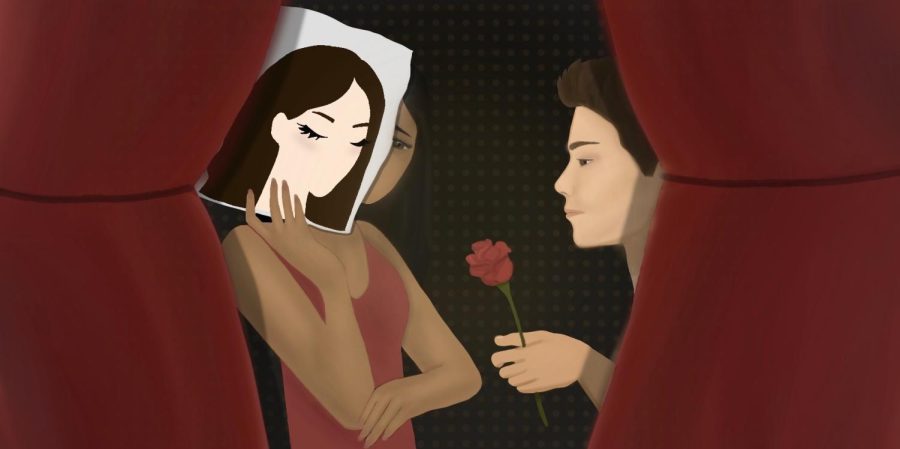Mirror mirror on the wall, who’s the fairest of them all: Colorism on dating shows promotes toxic and classicist beauty standards
Illustration by Ariana Goetting
Colorism is the discrimination of individuals based on skin color, with lighter-skinned individuals receiving preferential treatment compared to people with darker complexions. It often infiltrates beauty standards to emphasize fair skin as a part of the “pure, white and innocent” look. Margaret Wolfe Hungerford, an Irish romantic novelist in the 19th century, said, “Beauty is in the eye of the beholder,” but if the core of both typical western and international beauty has been reduced to one skin tone, is it even a matter of personal preference?
March 8, 2022
On a sunny day, the wind blows across a beach in Sayulita, Mexico as prospective couples fill a romantic resort. They happily pass the time with each other, while other contestants get to know each other in hopes of finding true love. Yet, in the midst of paradise, contestant Brendan Morais’ words, “She had zero prospects, it’s not like I was keeping her from someone” ring an alarm in the head of Natasha Parker, contestant and former partner of Brendan. In just a few seconds, Bachelor in Paradise has become “Bachelor in Hell” for Natasha, who faces not just the complications of love but also the pain of colorism.
Colorism is the discrimination of individuals based on skin color, with lighter-skinned individuals receiving preferential treatment compared to people with darker complexions. It often infiltrates beauty standards to emphasize fair skin as a part of the “pure, white and innocent” look. Margaret Wolfe Hungerford, an Irish romantic novelist in the 19th century, said, “Beauty is in the eye of the beholder,” but if the core of both typical western and international beauty has been reduced to one skin tone, is it even a matter of personal preference?
Throughout the beginning of the “Bachelor in Paradise” series, Brendan matched with Natasha, with the pair becoming a contented couple despite rumors that he was seeing friend and series contestant Pieper James, who had a lighter complexion than Natasha. Although Brendan later left Natasha to see Pieper in the show, his behavior could have been dismissed as an act of love for Pieper instead of colorism. Yet, his statement on Natasha’s lack of prospects and how he had supposedly done Natasha a favor by matching with her during the first few weeks of the series arises as a blatant display of colorism that reveals his inherent prejudices against darker skin tones. Natasha was arguably the contestant on the show with the darkest complexion, and Brendan explicitly stating that Natasha lacked prospects suggested that he viewed her as unattractive to the other contestants primarily due to his toxic perspectives on darker skin that can be inferred to suggest it was less desirable.
While many people globally of various ethnicities and cultures tend to have colorist perspectives, only a few individuals are conscious of their prejudices as opposed to the 90% of people who are unconsciously colorist, or have implicit bias, similar to Brendan Morais. Implicit bias commonly plagues dating shows in the U.S., with it mostly appearing through racism due to race’s prominence in dating, but colorist bias is the second most prevalent due to its associations with beauty. Unlike other forms of bias, racist and colorist prejudices are the hardest to suppress with conscious effort. Due to colorist biases being harder to eliminate than sexist or age prejudices, more people unknowingly harbor them, so subconscious colorism emerges frequently in situations dictated mainly by beauty standards, such as beauty pageants and dating shows.
These prejudices inflict damage far beyond the United States as colorist standards form the crux of harmful beauty standards in India.
From the brand Fair & Lovely, a skin-lightening product now known as Glow & Lovely, to the common phrase I’ve heard family and friends mention, “If only you were a little bit fairer you would be so much prettier,” colorism has vexed India for centuries. It is influenced by classicism and colonialist perspectives, starting from the concept that nobles and the upper class, such as the Aryans and Mughals had lighter skin. The British Raj, or the period of the British crown’s rule in India, exacerbated already existing colorism inherited from the early classicist colorism. British colonization emphasized the concept of “social Darwinism,” in which British officials discriminated against darker-skinned Indians by offering privileges to lighter-skinned citizens under the impression that genetically determined factors such as skin color and facial features were markers of intelligence. Today, although the British no longer rule parts of India, the colonialist beauty standards still affect Indians with darker skin tones. These people with darker complexions often face relentless bullying as children, lose jobs as flight attendants and news anchors and struggle to find prospective life partners who are fixated on marrying someone “beautiful.” In a 2015 survey conducted amongst 100 Indian college students, 71% of the participants attributed one aspect of being “pretty” to being “fair” or “light.” Comparatively, 55.36% of the female participants used bleaching products, despite 84% of the participants knowing that it is hazardous, embodying their extreme desire to have lighter skin.
At the heart of this problem is Netflix’s “Indian Matchmaking,” a reality dating show following matchmaker Seema Taparia’s process of arranging marriages for clients in India and the United States, that sparked debate over its blatant promotion of colorist beauty standards. Seema’s matchmaking process itself is rather classist by emphasizing arranged marriages, a method to link families and maintain status quo dating back thousands of years, but her standards in determining a match based on appearance are even more outdated, heavily highlighting the colorist preference of light skin in partners. Upon meeting client Pradhyuman Maloo, Seema begins to present his options, and only until she presents model Rushali Rai as a “fair and good-looking” girl does he show interest, revealing Pradhyuman and Seema’s detrimental colorist values. Seema’s overly enthusiastic portrayal of Rushali as a better prospect due to her being “fair” shows her colorist perspectives that link beauty and skin tone, while her statement blatantly insists that the fairer skinned clients she presented are superior to the darker ones. In response to the criticism regarding her statement, Seema further aggravated the show’s push towards colorist beliefs by stating in her interview with Condé Nast Traveller, “But who doesn’t want a fair, beautiful wife, you tell me.” Similarly, clients take more interest in paler individuals like many other Indian individuals, as 74% of male participants in a questionnaire among 100 university students in India on colorism preferred dating a lighter-skinned individual and 60.86% of the women surveyed desired going out with a fairer person.
The show’s perpetuation of colorist prejudices continues the harmful spread of colorism instead of resolving it, causing the formation of colorist biases within more people that will spread globally. Contrasting “Bachelor in Paradise,” “Indian Matchmaking” displays more scenarios of conscious colorism, due to the concept of “light is prettier” being more publicly advertised. While it may be the Indian environment they grew up in that constantly promoted being “fairer” and lighter, Seema and a variety of her clients possess a connate bias that rejects darker-skinned individuals, deeply rooted in the essence of colorism.
Further east in Korea, colorism has a significant role in a trend that has spread far beyond the country — k-beauty. K-beauty itself is simply a lifestyle or beauty trend, yet the standards it promotes makes it more damaging than healthy to follow the k-beauty lifestyle that follows a strict cosmetic and skincare routine. The standards take place in the form of a list populated by requirements for the ideal face and body, yet once again, the requirement for pale, white skin tops the list. Rooted in the notion that paler skin signifies luxury and royalty along with purity and innocence, beauty in Korea considers even slightly tan skin as “dark,” leading to whitewashing filters on movies and photos of celebrities.
Netflix’s “Singles Inferno,” a show that sets 12 singles on an island called Inferno and follows their escape to Paradise, or Paradise City Hotel in Incheon, South Korea, presents the issue that lies at the core of k-beauty’s colorist standards.
During the arrival of the various contestants on the island, singles Moon Sehoon and Choi Sihun both fell in love with contestant Shin Jiyeon. While their adoration for her appeared unaffected by prejudices, as they were bound to fall in love with someone that fit the standard of their ideal partner, both triggered an intense debate within non-South Korean audiences over their reasoning behind choosing Jiyeon. Sehoon’s reasoning for falling in love with her was that “her skin is so light,” and that “she seemed so white and pure.” Similarly, Sihun pointed out that his type was someone who adhered to the traditional standard, stating, “I like people with light skin.” Although suggesting that Jiyeon was beautiful and pure was not offensive, as Sehoon and Sihun could have wished to meet someone with a kind heart or innocent attitude, their conscious association of the trait with skin color is problematic by equating light skin to purity.
International audiences took extreme offense to this incident, with many viewers of the show calling out Netflix Korea for airing the colorist segments, as the desire for lighter skin is more welcome in Korea compared to outside countries. Korean netizens, or internet users, had an opposite classicist reaction to the controversy, stating, “If you have tanned or dark skin, people might perceive you as a manual laborer. Even if you look at the beauty standards during the Joseon Dynasty, they all had lighter skin. Even back then, having lighter skin meant you were from a wealthy family.” Similarly, Netflix Korea’s Vice President Kang Dong Han responded to the controversy, admitting that “Something may be okay in South Korea, but not okay in other countries … I see this all as a learning opportunity to become even better and am soaking it in with a humble attitude.”
Regardless of the culture and standards the audience members of the shows grew up with, colorist beauty standards remain an issue that can inflict insecurities on individuals. In dating shows, where the majority of decisions are sparked by visual interest, equating fair skin to beauty is a trigger and deteriorates confidence regarding appearance.
Upon watching “Singles Inferno,” hearing Sehoon attribute Jiyeon’s pure image to her pale skin made me contemplate, “Why does the notion of looking pure, clean, innocent and virtuous stem entirely from skin color?” I had never thought of skin color to be representative of beauty, but hearing contestants on dating shows prioritize fair-skinned individuals when listing their interests felt like a silent message, “Lighter skin makes you more beautiful.” In the days following their releases, the shows eventually led me to contemplate this idea through the perspective of contestants and clients on the shows. While taking a picture with a friend on the B612 and Snow photo app, a South Korean product under SnowCorp company that produces filters aligned with the country’s beauty standards, I noticed how filters made me look far lighter than I was in real life. Through the mindset “fairer is prettier,” I could not help but think that the whitewashed version of myself was prettier. It is this infectious characteristic of displaying colorist remarks on dating shows that creates such a toxic environment. While I waved the thought away a day later, deleting the B612 app as well to stop the idea from recurring, other audience members could retain it, carrying it with them as a standard of attractiveness. Others could take offense at the statements, potentially leading them to develop a negative body image or resort to hazardous treatments such as skin lightening, which is extremely prevalent in both India and South Korea.
Airing colorist beauty standards on shows spreads and reinforces the already existing plague that redefines beauty in the minds of many, and once the belief that “fairer” is prettier is ingrained in everyone’s minds, changing perceptions again is far too difficult. Perhaps avoiding colorist remarks on screen may provide less drama or spark less intensity in a show, but it reduces the propagation of harmful ideas, one individual at a time. In reality isn’t that what is truly fairer?


















![“[Building nerf blasters] became this outlet of creativity for me that hasn't been matched by anything else. The process [of] making a build complete to your desire is such a painstakingly difficult process, but I've had to learn from [the skills needed from] soldering to proper painting. There's so many different options for everything, if you think about it, it exists. The best part is [that] if it doesn't exist, you can build it yourself," Ishaan Parate said.](https://harkeraquila.com/wp-content/uploads/2022/08/DSC_8149-900x604.jpg)




![“When I came into high school, I was ready to be a follower. But DECA was a game changer for me. It helped me overcome my fear of public speaking, and it's played such a major role in who I've become today. To be able to successfully lead a chapter of 150 students, an officer team and be one of the upperclassmen I once really admired is something I'm [really] proud of,” Anvitha Tummala ('21) said.](https://harkeraquila.com/wp-content/uploads/2021/07/Screen-Shot-2021-07-25-at-9.50.05-AM-900x594.png)







![“I think getting up in the morning and having a sense of purpose [is exciting]. I think without a certain amount of drive, life is kind of obsolete and mundane, and I think having that every single day is what makes each day unique and kind of makes life exciting,” Neymika Jain (12) said.](https://harkeraquila.com/wp-content/uploads/2017/06/Screen-Shot-2017-06-03-at-4.54.16-PM.png)








![“My slogan is ‘slow feet, don’t eat, and I’m hungry.’ You need to run fast to get where you are–you aren't going to get those championships if you aren't fast,” Angel Cervantes (12) said. “I want to do well in school on my tests and in track and win championships for my team. I live by that, [and] I can do that anywhere: in the classroom or on the field.”](https://harkeraquila.com/wp-content/uploads/2018/06/DSC5146-900x601.jpg)
![“[Volleyball has] taught me how to fall correctly, and another thing it taught is that you don’t have to be the best at something to be good at it. If you just hit the ball in a smart way, then it still scores points and you’re good at it. You could be a background player and still make a much bigger impact on the team than you would think,” Anya Gert (’20) said.](https://harkeraquila.com/wp-content/uploads/2020/06/AnnaGert_JinTuan_HoHPhotoEdited-600x900.jpeg)

![“I'm not nearly there yet, but [my confidence has] definitely been getting better since I was pretty shy and timid coming into Harker my freshman year. I know that there's a lot of people that are really confident in what they do, and I really admire them. Everyone's so driven and that has really pushed me to kind of try to find my own place in high school and be more confident,” Alyssa Huang (’20) said.](https://harkeraquila.com/wp-content/uploads/2020/06/AlyssaHuang_EmilyChen_HoHPhoto-900x749.jpeg)











